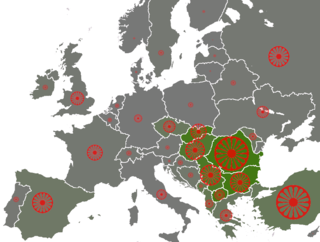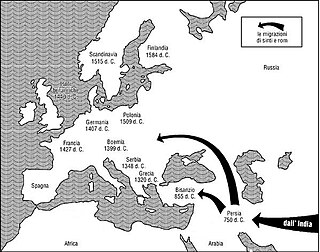
The Romani, also spelled Romany or Rromani and colloquially known as the Roma, are an ethnic group of Indo-Aryan origin who traditionally lived a nomadic, itinerant lifestyle. Linguistic and genetic evidence suggests that the Romani originated in the Indian subcontinent, in particular the region of present-day state of Rajasthan. Their subsequent westward migration, possibly in waves, is now believed by historians to have occurred c. 1000 CE. Their name is from the Sanskrit word डोम which means a member of the Dom caste of travelling musicians and dancers. The Roma population moved west into the Ghaznavid Empire and later into the Byzantine Empire. The Roma are thought to have arrived in Europe around the 13th to 14th century. Although they are widely dispersed, their most concentrated populations are believed to be in Bulgaria, Hungary, Romania, Serbia and Slovakia.

The Romani Holocaust was the planned effort by Nazi Germany and its World War II allies and collaborators to commit ethnic cleansing and eventually genocide against European Roma and Sinti peoples during the Holocaust era.
The Romani people have long been a part of the collective mythology of the West, where they were depicted as outsiders, aliens, and a threat. For centuries they were enslaved in Eastern Europe and hunted in Western Europe: the Pořajmos, Hitler's attempt at genocide, was one violent link in a chain of persecution that encompassed countries generally considered more tolerant of minorities, such as the United Kingdom. Even today, while there is a surge of Romani self-identification and pride, restrictive measures are being debated and passed by democratic states to curb the rights of the Romani people.

The Romanichal are a Romani subgroup within the United Kingdom and other parts of the English-speaking world. Most Romanichal speak Angloromani, a mixed language that blends Romani vocabulary with English syntax. Romanichal residing in England, Scotland, and Wales are part of the Gypsy, Roma, and Traveller community.
Bohemian Romani or Bohemian Romany was a dialect of Romani formerly spoken by the Romani people of Bohemia, the western part of today's Czech Republic. It became extinct after World War II, due to the genocide of most of its speakers in extermination camps by Nazi Germany.
The Romani people, also referred to as Roma, Sinti, or Kale, depending on the subgroup, are an Indo-Aryan ethnic group that primarily lives in Europe. The Romani may have migrated from what is the modern Indian state of Rajasthan, migrating to the northwest around 250 BC. Their subsequent westward migration, possibly in waves, is now believed to have occurred beginning in about 500 AD. It has also been suggested that emigration from India may have taken place in the context of the raids by Mahmud of Ghazni. As these soldiers were defeated, they were moved west with their families into the Byzantine Empire.

The Romani people are a distinct ethnic and cultural group of peoples living all across the globe, who share a family of languages and sometimes a traditional nomadic mode of life. Though their exact origins were unclear, recent studies show Kashmir in Northwest India is the most probable point of origin. Their language shares a common origin with, and is similar to, modern-day Gujarati and Rajasthani, borrowing loanwords from languages they encountered as they migrated from India. In Europe, even though their culture has been victimized by other cultures, they have still found a way to maintain their heritage and society. Indian elements in Romani culture are limited, with the exception of the language. Romani culture focuses heavily on family. The Roma traditionally live according to relatively strict moral codes. The ethnic culture of the Romani people who live in central, eastern and southeastern European countries developed through a long, complex process of continuous active interaction with the culture of their surrounding European population.

The Romani flag or the flag of the Roma is the international ethnic flag of the Romani people, historically known as "Gypsies", which form a stateless minority in countries across Eurasia, Africa, the Americas, and Australasia. It was approved by the representatives of various Romani communities at the first and second World Romani Congresses (WRC), in 1971 and 1978. The flag consists of a background of blue and green, representing the heavens and earth, respectively; it also contains a 16-spoke red dharmachakra, or cartwheel, in the center. The latter element stands for the itinerant tradition of the Romani people and is also an homage to the flag of India, added to the flag by scholar Weer Rajendra Rishi. It superseded a number of tribal emblems and banners, several of which evoked claims of Romani descent from the Ancient Egyptians.

The International Romani Day is a day to celebrate Romani culture and raise awareness of the issues facing Romani people.
"Gelem, Gelem" is a song composed by Žarko Jovanović, often used as the anthem of the Romani people. The title has been adapted in many countries by local Roma to match their native orthography and spoken dialect of the Romani language.

The Romani people have several distinct populations, the largest being the Roma and the Calé, who reached Anatolia and the Balkans in the early 12th century, from a migration out of the Indian subcontinent beginning about 1st century – 2nd century AD. They settled in the areas of present-day Turkey, Greece, Serbia, Romania, Croatia, Moldova, Bulgaria, North Macedonia, Hungary, Albania, Kosovo, Bosnia and Herzegovina, Czech Republic, Slovenia and Slovakia, by order of volume, and Spain. From the Balkans, they migrated throughout Europe and, in the nineteenth and later centuries, to the Americas. The Roma population in the United States is estimated at more than one million.
Krisi or Krisi-Romani is a traditional court for conflict resolution in the culture of Vlax branch of the Romani people. The term derives from the Greek language, "κρίση" (judgment). It is a key institution for enforcing the Romani Code within Romanipen. It developed in the area of present-day Romania, during the times of the slavery, as a judicial institution of the local Romanies, in order to enforce the community cohesion and its internal balance. After the abolition, from the half of the 19th century onwards, many Vlax Romanies emigrated in the rest of the world, bringing with them the krisi as part of their cultural luggage. More or less formal proceedings exist also among other Romani branches. Some non-Vlax Romanies adopted this institution, like the Drzara from Sweden, in contact with the local Kalderash.
The Romani people are known by a variety of names, mostly as Gypsies, Roma, Tsinganoi, Bohémiens, and various linguistic variations of these names. There are also numerous subgroups and clans with their own self-designations, such as the Sinti, Kalderash, Boyash, Manouche, Lovari, Lăutari, Machvaya, Romanichal, Romanisael, Kale, Kaale, Xoraxai and Modyar.
Sinte Romani is the variety of Romani spoken by the Sinti people in Germany, France, Austria, Belgium, the Netherlands, some parts of Northern Italy and other adjacent regions. Sinte Romani is characterized by significant German influence and is not mutually intelligible with other forms of Romani. The language is written in the Latin script.

Romani Americans are Americans who have full or partial Romani ancestry. It is estimated that there are one million Romani people in the United States. Though the Romani population in the United States has largely assimilated into American society, the largest concentrations are in Southern California, the Pacific Northwest, Southwestern United States, Texas, Louisiana, Florida and the Northeast as well as in cities such as Chicago, Cleveland, and St. Louis.

The International Romani Union, formerly known as the International Gypsy Committee and International Rom Committee, is an organization active for the rights of the Romani people. Its seat is in Vienna. The International Romani Union also has offices in Skopje, North Macedonia, and Washington, D.C., US.

The Romani people in Poland, also known as the Roma, qualify as an ethnic minority group in Poland of Indo-Aryan origins. The Council of Europe regards the endonym "Roma" more appropriate when referencing the people, and "Romani" when referencing cultural characteristics. The term Cyganie is considered an exonym in Poland.

The Romani people in Australia are citizens of Australia who are of Romani descent. They are sometimes referred to as Roma. Most Roma in Australia trace their roots to the United Kingdom and Greece, who in return trace their roots to northern India.

Gheorghe A. Lăzăreanu-Lăzurică or George Lăzurică, also known as Lăzărescu-Lăzurică or Lăzărică, was a leader of the Romani (Gypsy) community in Romania, also remembered for his support of Romania's interwar far-right. Originally a musician and formally trained entrepreneur from an assimilated background, he became conscious about his ethnic roots while serving with the Romanian Land Forces in World War I. A pioneer of Romani-themed literature, he became active within the General Association of Gypsies in Romania in 1933, but broke away that same year to establish the General Union of Roma in Romania. From September 1933 to May 1934, Lăzurică was also a "Voivode of the Gypsies", recognized as such by various local tribes. He and his followers came to resent ethnic designation as "Gypsies", and pleaded for the usage of "Romanies", first proposed to them by Nicolae Constantin Batzaria. Lăzurică himself tried to introduce the term Zgripți as a reference to the people's legendary ancestors.

Santino Spinelli is an Italian Romani musician, composer and teacher.










